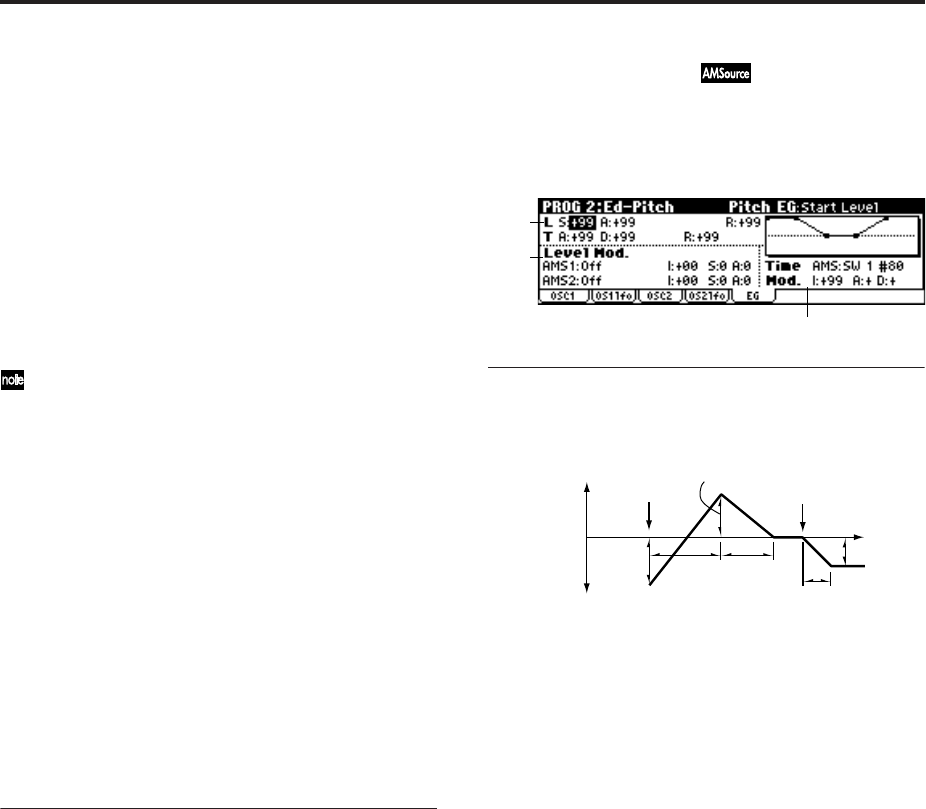
12
Intensity (AMS Intensity) [–12.00…+12.00]
Specifies the depth and direction of the effect that “AMS
(LFO1 AMS)” will have.
With a setting of 0, modulation will not be applied. With a
setting of 12.00, the OSC1 LFO1 will apply a maximum of ±1
octave of pitch modulation. Negative (–) settings will invert
the LFO waveform.
For example if “AMS (LFO1 AMS)” is set to Pedal #04, Glo-
bal 0–3a “Foot Pedal Assign” is set to Foot Pedal (CC#04),
and you advance a foot pedal connected to the ASSIGN-
ABLE PEDAL jack, the pitch modulation produced by OSC1
LFO1 will be applied in the normal phase if you have
assigned a positive (+) value, or in the reverse phase if you
have assigned a negative (–) value.
The depth and direction of the pitch modulation pro-
duced by OSC1 LFO1 depends on the sum of the settings
for “Intensity (LFO1 Intensity),”
X50:
“M.Whl+Int.”
(LFO1 MWheel+Int.)”/
microX:
“JS+Y Int. (LFO1 JS+Y
Int.),” and “AMS (LFO1 AMS). (
☞
p.154)
LFO2:
Intensity (LFO2 Intensity) [–12.00…+12.00]
X50: Mod.Whl Int. (LFO2 Mod.Whl Int.)
[–12.00…+12.00]
microX: JS+Y Int. (LFO2 JS+Y Int.)
[–12.00…+12.00]
AMS (LFO2 AMS)
[Off, (PEG, FEG, AEG, KT, EXT)]
Intensity (AMS Intensity) [–12.00…+12.00]
Refer to the preceding section “LFO1.”
■ 2–2: UTILITY
☞“Write Program” (0–1), “Copy Oscillator,” “Swap Oscilla-
tor” (1–1)
2–3: OSC2
Specifies how the key position (on the keyboard) will affect
the pitch of oscillator 2, and selects the controller that will
affect the pitch and specify the depth of control. Here you
can also specify the amount of pitch change produced by the
pitch EG, and set the portamento mode and on/off status.
For details on each parameter, refer to the preceding “2–1:
OSC1.”
2–4: OS2lfo (OSC2 LFO)
Specifies the amount of pitch change produced by LFO1 and
LFO2 for oscillator 2. For an explanation of each parameter,
refer to the preceding “2–2: OS1lfo.”
2–5: EG (Pitch EG)
Here you can make settings for the pitch EG, which creates
time-variant changes in the pitch of oscillators 1 and 2.
The depth of pitch change produced by these EG settings on
oscillator 1 (2) is adjusted by “Pitch EG” (2–1b, 2–3).
2–5a: Pitch EG
These settings specify how the pitch will change over time.
L (Level parameters):
These parameters specify the amount of pitch change.
The actual amount of pitch change will depend on the
“Pitch EG” (2–1b, 2–3) parameter “Intensity.”
For example with an “Intensity” setting of +12.00, a “Level”
setting of +99 would raise the pitch one octave, and a
“Level” setting of –99 would lower the pitch one octave.
S (Start Level) [–99…+99]
Specifies the amount of pitch change at note-on.
A (Attack Level) [–99…+99]
Specifies the amount of pitch change when the attack time
has elapsed.
R (Release Level) [–99…+99]
Specifies the amount of pitch change when the release time
has elapsed.
T (Time parameters):
These parameters specify the length of time over which the
pitch change will occur.
A (Attack Time) [0…99]
Specifies the time over which the pitch will change from
note-on until it reaches the pitch specified as the attack level.
D (Decay Time) [0…99]
Specifies the time over which the pitch will change after
reaching the attack level until it reaches the normal pitch.
R (Release Time) [0…99]
Specifies the time over which the pitch will change from
note-off until it reaches the pitch specified as the release
level.
2–5a
2–5b
2–5c
Note-on
Note-off
Attack
Time
Decay
Time
Start Level
Release Level
Release Time
Attack Level
+99 = approximately 1 octave
–99 = approximately 1 octave
0 = pitch when
key is held
(sustained)
Time
Time-varying pitch settings (when Pitch EG Intensity = +12.00)


















